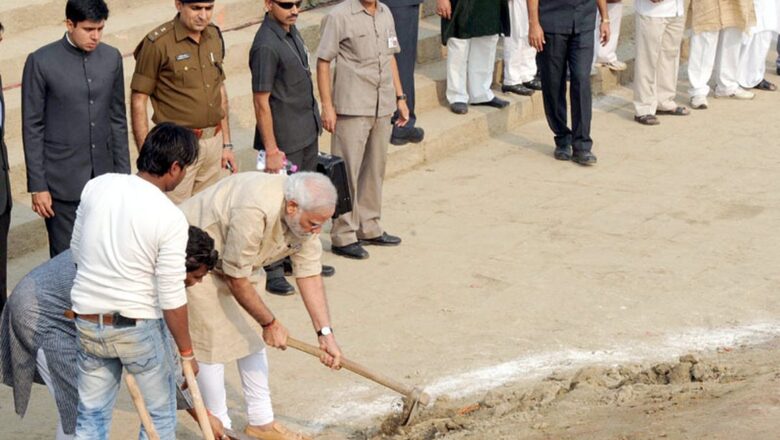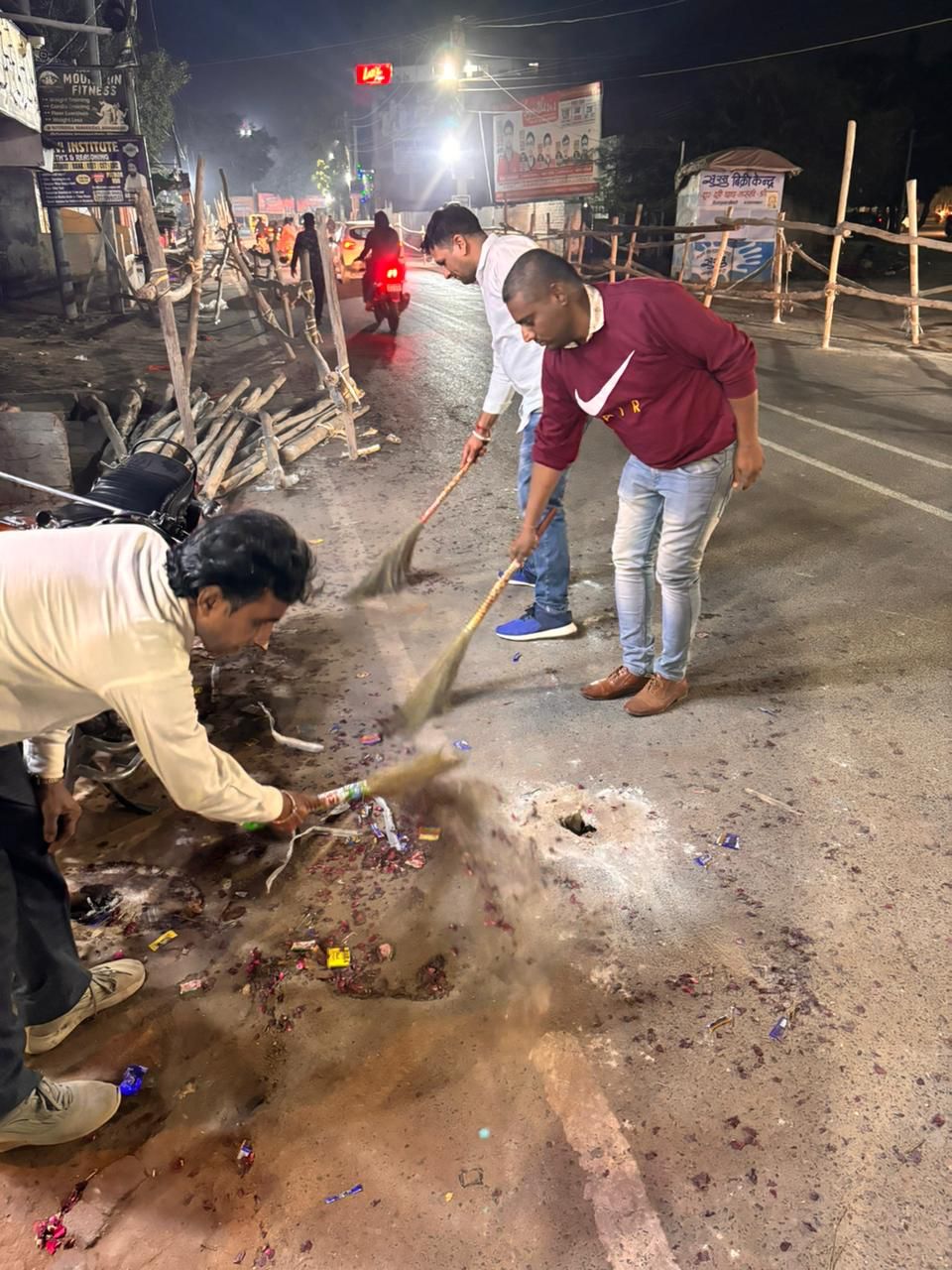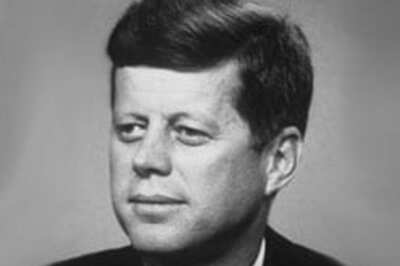
views
Narendra Modi’s passion for the cleanliness drive initiated by him was demonstrated at a recent roadshow in Bikaner on Monday. Thousands of people had gathered on both sides of the road during the rally, with chants of “Modi, Modi” reverberating. They were also showering the PM with flowers. As is common with events of such scale, the ground was covered with banners, pieces of paper, and flowers by the time the roadshow was over. Visuals like this are also common on TV. Over the past two decades, be it as Gujarat’s chief minister or as India’s prime minister since 2014, Narendra Modi has been hugely popular among the masses and his roadshows receive a rousing reception.
But the visuals that aren’t shown or discussed as much are of the sanitation process following these events, which Modi stresses on. He ensures that the party workers who diligently organise his roadshows also clean up the site littered with flowers, flags, banners, etc, afterwards.
Example set at Bikaner roadshow
This was evident again as within hours of the Bikaner event, BJP workers had picked up brooms and cleaned up the entire road overnight, better than before. PM Modi has instructed party workers who organise the roadshows to ensure that there is no litter lying around afterwards and cleanliness is maintained at all costs.

It’s also an interesting fact that PM Modi has placed a condition to lead any public event anywhere in the country. The BJP-led government or municipal authority of the area or, in their absence, the local party workers have to ensure that not just the programme site but the entire town or city is sanitised a week before the event. If this is not done, PM Modi refuses to partake in the function. The latest example is Mathura. The PM has an event there on November 23 and the local administration and BJP workers have been engaged in a clean-up operation to ensure his presence. Organisers have to send across pictures of the progress to the prime minister’s office. Narendra Modi had initiated this practice as Gujarat chief minister and since then there has been no letup.
How it started in 2014
Party leaders are aware of Narendra Modi’s emphasis on cleanliness. That’s because a few months after he took over his duties as the Prime Minister of India in May 2014, on the occasion of Independence Day, in his speech from the ramparts of the Red Fort, Modi had given a clarion call for the Swachh Bharat Abhiyan and formally launched this nationwide campaign on October 2, 2014, the birth anniversary of Mahatma Gandhi. A target was set to eliminate the practice of open defecation from the country by the ‘Father of the Nation’s’ 150th birth anniversary in 2019 as a tribute to him.
10 crore toilets in 5 years
The fact that over 10 crore toilets were constructed in Indian homes between 2014 and 2019 provides an indication of the campaign’s success. Prior to the commencement of this programme, the nation’s sanitation coverage was only 39%; in 2019, that number rose to 100%, and over six lakh villages nationwide were deemed open-defecation free (ODF).
Cash from trash
After the Swachh Bharat Mission’s first phase proved successful, Prime Minister Modi decided to expand the campaign. In 2020, the mission’s second phase was initiated, with a budget of around one lakh forty-one thousand crore rupees, and the goal of making all Indian villages ODF-plus by 2024–2025, so that not just the environment of sanitation is maintained but waste can be properly utilised in an eco-friendly way so that it can also be a source of income for locals is also taken care of. In this second phase, the government has achieved considerable success so far.
Both urban and rural communities are seeing the effects of the Swachh Bharat Abhiyan. According to the Ministry of Urban Development’s most recent figures, in 2014, only 17% of India’s urban garbage was processed; by 2023, that figure had risen to 76%. These numbers, of course, provide a glimpse of how, under Modi’s leadership, the habit of cleanliness is evolving throughout India.
Efforts as Gujarat CM
The drive for cleanliness, however, dates back to way before Narendra Modi took on the reins of the country. The seeds were sown right when he was the chief minister of Gujarat. Few would remember that Narendra Modi initiated a number of cleanliness projects throughout Gujarat shortly after taking office as CM in October 2001. Beginning with the secretariat in Gandhinagar, the seat of the state government, Modi began a campaign on a war footing, whether it was to get rid of the cars that had been gathering dust on the secretariat campus for years or the useless stacks of files lying around for decades.
No files on his table
The process of digitisation in the secretariat gained momentum to ensure that government files did not appear in the form of paper. The secretariat saw a sea change as the chambers of ministers and officials that were brimming with files started sporting a cleaner look, and the pace of work also gathered speed. Transparency was also ushered in as online monitoring of files also became possible. Files that kept gathering dust on the tables of ministers and officials disappeared. Modi himself set the example. Be it as chief minister of Gujarat or Prime Minister of India, not a single file could be found on his table.
Modi’s campaign for cleanliness extended beyond desks and files to include roads, villages, universities, and streets. There were cleanliness campaigns from the major towns down to the rural level. As CM, while going around the state in the summer months to promote education for girls, he also ensured clean toilets in government schools in every village of Gujarat.
Modi even ensured public participation in this campaign of cleanliness. He connected business houses, socio-religious institutions, as well as women’s self-help groups with this campaign. Modi made sure that even public parks, where people stroll in the morning, were clean, with the assistance of all these groups. He held sanitation workers in high regard and also constantly encouraged them, calling cleanliness God’s work and giving the example of Mahatma Gandhi. He has even washed the feet of sanitation workers to send a message to society.
PM Modi’s ‘sweep shots’
Modi has himself been seen a number of times with a broom in his hand out on the streets, which has also inspired officials as well as the public. Sanitation has been a part of India’s culture and habits. In Gujarat, where Modi comes from, it’s often considered poor manners to enter a home, or even a shoe shop, with footwear on.
Having spent his childhood years in Mehsana district’s Vadnagar, Modi picked up the habit of sanitation at home and school. His penchant for keeping the country clean also has its roots in his early days of joining the Rashtriya Swayamsevak Sangh (RSS). The basic initiation into the Sangh starts with a ritual of cleanliness where pracharaks clean the shakhas every day. Modi, who started out at the Sangh office in Ahmedabad in the 1970s, used to clean it every day, first thing in the morning. An RSS pracharak is taught to wash his own clothes and maintain cleanliness around.
Modi emphasised on cleanliness in the BJP’s state organisation even in 1986-87, when he joined the party from the Sangh in an effort to fortify its structure in Gujarat. Reporters and friends from that era recall how Modi fixed the Ahmedabad office in Khanpur and made sure it was clean. In Gandhinagar, as chief minister, he opened the BJP’s new headquarters and also emphasised on sanitation there, which is evident even now.
Modi’s office and residence bear no resemblance to usual government buildings but look spic and span like they belong to a private company’s CEO. In fact, Modi had presented himself as Gujarat’s CEO while attempting to entice foreign and Indian investors to the state as part of the 2003 launch of the Vibrant Gujarat campaign. Modi still feels this way even as the Prime Minister of India and is aware that in addition to building infrastructure, India must prioritise cleanliness if it hopes to become a worldwide manufacturing hub or emerge as a global leader.
Children taking the lead
The results of Modi’s Swachh Bharat Abhiyan have also become evident over the past 9 years. Cleanliness has improved in a number of locations, including airports, train stations, and popular tourist destinations. People no longer spit paan or drop cigarette ash everywhere; instead, they search for the nearest dustbin. The younger generation too has been instrumental in promoting this change, and they even rebuke adults if they fail to adhere to sanitation practices.
Digging deep
Modi has not just relied on speeches to ensure the success of the cleanliness drive but has on numerous occasions come down to the field himself and directly associated himself to provide inspiration. If you refresh your memories, after his victory from Varanasi in the Lok Sabha elections, Modi came down to Assi Ghat with a shovel in his hand on November 8, 2014, to participate in the cleaning process. The video, flashed across numerous television channels and the internet, had become a beacon of inspiration nationwide. As the oldest city of India, Varanasi, once infamous for its filth, now has clean streets, lanes, temples, and ghats, wowing lakhs of visitors coming here. As Varanasi’s MP, Modi has been able to usher in this sea change in a mere 9 years.
In October 2019, images showed Modi gathering trash from the shoreline in Mahabalipuram, close to Chennai, and placing it in a bag in his hand. He didn’t shy away from picking up any litter lying around with his own hands. Modi hasn’t just focused on cleanliness but also on how to get rid of waste, as well as using it productively, like fixing roads, creating artwork, or generating electricity.

Not slowing down
Cleanliness has become a positive phenomenon among Indians. But PM Modi is not prepared to rest on his laurels. He wants to ensure that this practice remains a habit. Recently, the BJP’s Diwali Milan programme offered a peek into this. The PM made an appeal for collaboration in sanitation on the afternoon of November 17, when he addressed a large gathering of journalists in Delhi. Modi thanked the media for its constructive contribution to the Swachh Bharat Abhiyan and asked it to keep up its backing so that India is regarded as one of the world’s cleanest nations.
Modi knows very well that cleanliness is not only related to good health but also to the reputation of the country. The West has always portrayed India as a country of conjurers, beggars, filthy streets, and drains. And if that country is now gaining repute because of cleanliness, then the pace cannot slacken. That is why PM Modi is not just setting an example in this direction but is also providing constant encouragement to the nation.




















Comments
0 comment